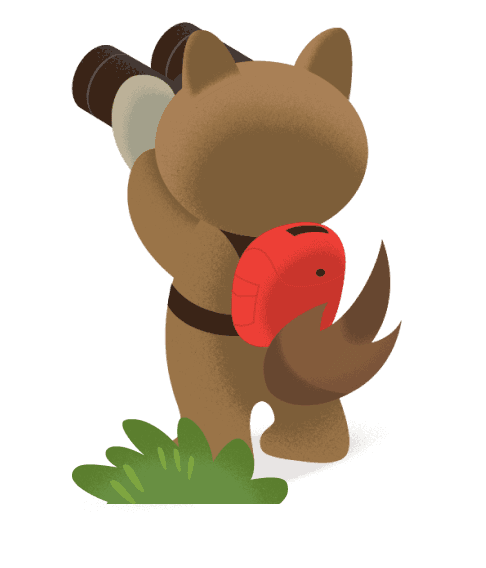7 DesignOps Tips to ‘Un-silo’ Your Product Teams

Dialogue and bridging knowledge gaps improve ability to deliver customer success.

Laura Gatewood and Dan LeBoeuf
Silos happen. Even when different design teams work on the same products, using the same tools and design system, it takes effort to be consistent about collaboration. That’s where design operations – or DesignOps – comes in.
When teams don’t work together, it can affect how a customer or end user experiences your product. How do you get busy co-workers to be more intentional about cross-team engagement? As members of the DesignOps team within product UX at Salesforce, we’re dot connectors and bridge builders. We were curious about what it would take to un-silo two teams and get them to strengthen their working relationship.
What is DesignOps?
Short for design operations, the DesignOps team at Salesforce builds systems, processes, tools, and frameworks that help the product UX organization deliver their work. DesignOps focuses on the how so that product UX can focus on the what.
How design operations approaches challenges
One of our product UX teams craved getting more insights about actual customer experience and needs but didn’t know whom or how to ask to get regular access. On the other side, we have an XD (experience design) team that has daily interactions with customers who willingly share their user issues, wish lists, and more. But XD didn’t have the depth of knowledge about product UX and upcoming feature developments to address customers’ queries.
7 DesignOps tips for how to un-silo teams
We suspected that if UX and XD could meld their minds, the collaboration would yield only good benefits for the end users.
We piloted a year-long program to facilitate the exchange of expertise, which successfully helped our teams connect and develop a rich working relationship. And, because it’s not design operations without process or scaffolding, we followed best practices for change management. We have seven tips for how we un-siloed these teams:
- Identify knowledge gaps.
- Partner with team leaders.
- Launch communications channels.
- Generate collective wisdom.
- Spark curiosity.
- Experiment, assess, and iterate.
- Reinforce best practices.
1. Identify knowledge gaps
When tackling silos, it’s important to start with a discovery phase to learn what the issues and goals are. In our case, we needed to identify and address the knowledge gaps that caused the most challenges to delivering customer satisfaction. Once DesignOps understood where teams needed more insights to improve outcomes, we then knew exactly what we were solving for and the resulting benefits we could expect from un-siloing our design teams.
2. Partner with team leaders
Getting buy-in from the senior leaders who set organizational priorities is essential to aligning teams around a vision. Un-siloing teams starts at the top.
Leaders who model collaborative behavior signal to their teams the expectation to do the same. These leaders committed to participating in events and investing in the new community by offering ideas to spur engagement, which was critical to our success.
DesignOps learned that senior leaders also can hold space for emerging leaders to rise to new opportunities. Encouraging peer leadership meant that teams felt empowered to make connections and act instead of waiting for directives from managers.
3. Launch communications channels
In DesignOps, we strive to break down barriers that might prevent designers from doing their best work. Ensuring there are clear channels of communications is a key component to building a new community.
We created a home base on Slack, using a series of prompts to help both teams get to know and learn from one another, and celebrate individual and team successes. We also set up a framework of events for our teams to meet and work together.
Our inaugural event featured team overviews and product deep dives. Subsequent events deepened connections by using workshop-style interactions, where both teams participated in design reviews and feedback sessions. This created visibility into each team, which increased mutual awareness about and appreciation for the teams’ respective expertise.
4. Generate collective wisdom
When teams have a deeper understanding of one another, it taps into a broader range of insights and viewpoints. We hosted virtual workshops where participants from UX and XD could use anonymous sticky notes to share ideas, thoughts, and feedback. This created a safe and inclusive space for all to contribute freely, especially those who might experience anxiety in group settings.
As a result, we got a diversity of comments that enriched the collective wisdom. This method transformed the idea-sharing process into an integral part of shaping a cohesive and inclusive group dynamic.
5. Spark curiosity
With DesignOps support, leaders polled their teams to identify burning questions and specific pain points that their counterparts might be able to address. We sorted the list according to company priorities and developed programming for the pilot.
Raising awareness about what teams wanted to learn and creating mechanisms to support ongoing exchange sparked curiosity. A couple months into our pilot, the UX and XD teams were clear on how they could help one another and how to initiate collaborative design reviews.
As DesignOps learned about success stories from these interactions, we amplified them on Slack, which triggered even more interest in cross-team collaboration. This cycle fed the culture of curiosity among the teams and opened new pathways to connect.
6. Experiment, assess, and iterate
Building the relationships that form a community – in order to un-silo teams, for example – takes time, flexibility, and commitment. When orchestrating long-term initiatives, it’s necessary to experiment, assess, and measure performance or impact.
Our DesignOps team, as a “scaling engine,” provided the structure to support continuous improvement in this pilot.
We identified strengths and weaknesses that allowed us to twist the dial in the direction of a more collaborative landscape. For example, we discovered that short, emoji-vote prompts outperformed open-ended questions for channel engagement. Short posts were better than long, formal posts. We refined strategies, discarded what wasn’t working, and amplified successful approaches.
7. Reinforce best practices
We learned that people needed more than a single exposure to the advantages of cross-team collaboration before they were ready to embrace it. They also needed a predictable cadence for communications.
It took continual dialogue and direct experience to help them internalize the value of seeking cross-team partners. Through the pilot, we modeled how UX and XD might work together. Eventually, team members were able to initiate their own exchanges. By year’s end, our Slack community engagement had increased 150% from launch.
Building a bridge to success
How did we do? A marketing vice president on the UX team commented: “(Feedback sessions) with the XD team not only helps shape deep design insights that UX could not otherwise create, they also help us develop a deeper awareness of the product’s future expectations that will better support our customers directly.”
An XD director described being able to identify a user’s accessibility needs and get the right support from her UX partners to deliver a solution that surpassed the customer’s expectations.
Silos don’t have to happen. Making it easy for teams to connect the dots is the antidote.
We believe that business is the greatest platform for change, and success should be for everyone on Earth and the planet itself. Because the new frontier? It’s right here.





























